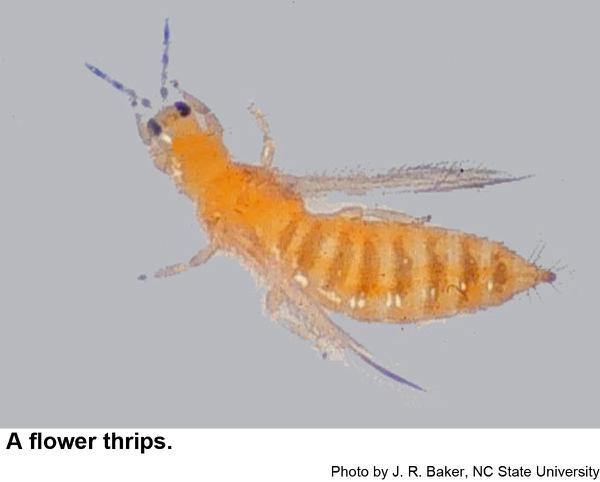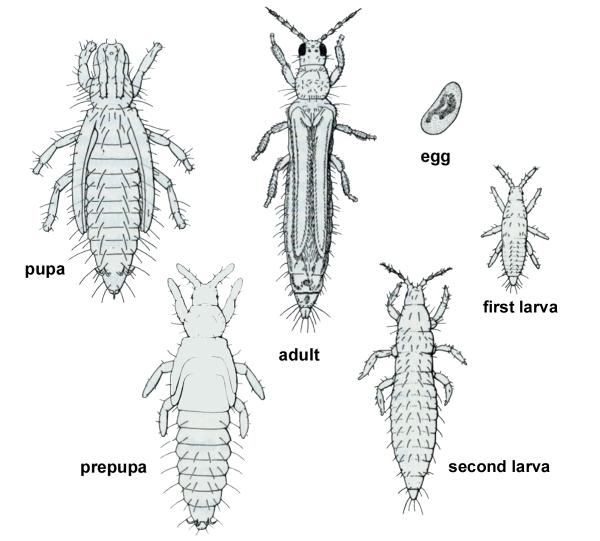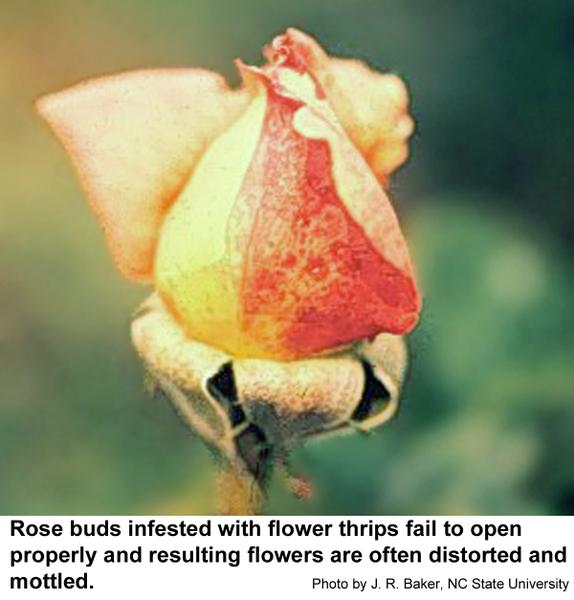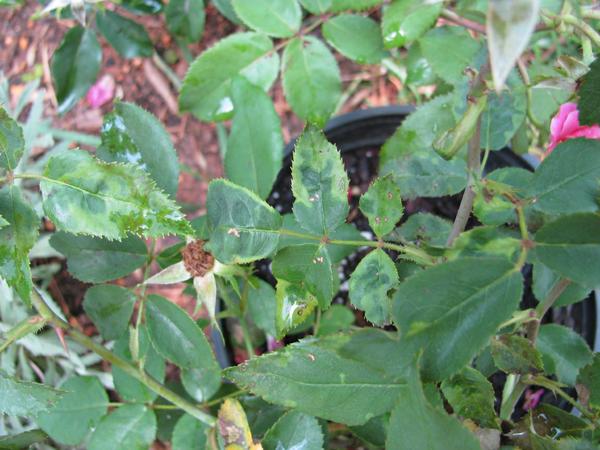General Information
The word thrips is a direct transliteration of the Greek word for wood worm, φριψ, so that the word thrips is both singular and plural. The flower thrips, Frankliniella tritici, is sometimes called the eastern flower thrips (to distinguish it from the western flower thrips). Female flower thrips are yellowish-brown to amber with an orange thorax and barely visible to the eye (1⁄16 inch). Males are slightly smaller and paler than females. Under a microscope, the most notable character are the fringed or feather-like wings. The flower thrips' delicate egg is inserted completely into the plant tissue. The egg is cylindrical and kidney-shaped, with a smooth pale or yellow surface. Immature thrips are yellow and resemble adults except for size and lack of wings. Prepupae are pale and have wing buds and antennae that are to the side or front of the head. Pupae are also pale and have longer wing buds and antennae that bend back over the head.
Biology
First described in 1855 in New York, flower thrips are one of the most numerous insect pests of ornamental plants. As cereal crops and feral grasses dry out during early summer, swarms of these tiny, orange insects fly especially in late afternoon. Thrips bite people, causing a minor, but noticeable itch. Their large numbers account for considerable and rapid damage to flowers, especially those with pale petals. (Yet thrips contribute to pollination of some crops, an unexpected benefit!)
Flower thrips are generally found within buds or in flowers at the base of the flower petals. They reproduce throughout the year in North Carolina, with the majority of their 12 to 15 generations occurring in the warmer months. Newly emerged females begin to lay eggs within 1 to 4 days in summer and within 10 to 35 days in winter, reproduction being much faster in warmer weather. In summer, it takes about 11 days to reach the adult stage. Flower thrips pass through egg, 2 larval, prepupal, pupal and adult stages. The eggs are inserted into flower or leaf tissue, and the prepupal and pupal stages are spent in the soil. During summer, flower thrips may live 26 days, though overwintering thrips may live all winter.
Because of their small size, flower thrips are carried over large areas by frontal wind systems. They have even been trapped at altitudes of 10,000 feet. Flower thrips are found throughout North Carolina with peak migration during the first week of June. Flower thrips feed by piercing the leaf or petal surface and drawing sap from injured cells. Only the epidermis and relatively few mesophyll cells are affected. On ornamental plants, this damage is restricted to the flowers. For example, rose blossoms turn brown and buds open only partially. The petals, distorted with brown edges, seem to stick together. The past few years we have seen much damage by flower thrips on 'Knock Out' roses in nurseries. They have proven a formidable pest and the best control will come with early identification of the problem. Flower thrips are smaller than western flower thrips and can be beaten from plants into a tray or onto a clipboard. They cause mottling, deformation and discoloration of foliage on roses and other plants.
Host Plants
Flower thrips have been collected from 29 plant orders including various berries, cotton, day lilies, field crops, forage crops, grass flowers, legumes, peonies, privet, rose, trees, truck crops, and vines. They seem to prefer grasses and flowers with yellow or pale blossoms. Roses are most susceptible in June.
Control
Control of flower thrips is difficult because of constant migration from weeds, grass, flowers and trees. Shortly after treatment, new thrips often migrate back onto plants. On roses, old blossoms should be destroyed and applications of pesticides made at close intervals, especially in late May and June. However, treating open blossoms is likely to kill pollinators. Also, treating open blossoms may result is pesticide injury (irrigating thoroughly and treating during cooler parts of the day usually helps avoid phytotoxicity). Control, mow or reduce weeds and/or grasses in the vicinity all season long. Monitor populations with yellow sticky cards.
For a key to thrips identification see Insect and Related Pests of Flowers and Foliage Plants.
The following pesticides give adequate control of flower thrips on a short-term basis.
| Active Ingredient | Trade Name | Thrips Stage Affected | Signal Word | IRAC MOA Group | Compatible with Beneficials |
|---|---|---|---|---|---|
| abamectin | Avid | L, A | Caution | 6 | Yes |
| acephate* | Orthene | L, A | Caution | 1B | No |
| acetamiprid | TriStar | L, A | Caution | 4A | Yes |
| azadirachtin* | Azatin | L | Caution | 18B | Yes |
| bifenthrin* | Talstar | L, A | Caution | 3 | No |
| cyfluthrin | Decathlon | L, A | Caution | 3 | No |
| fenpropathrin | Tame | L, A | Caution | 3 | No |
| horticultural oil* | many | L, A | Warning | - | Yes |
| kinoprene | Enstar II | L | Warning | 7A | Yes |
| novaluron | Pedestal | L | Caution | 15 | Yes |
| spinosad* | Conserve | L, A | Caution | 5 | Yes |
| * Suitable for home use or some consumer products available with identical active ingredient. When used as directed, pyrethroids are very toxic to insects but are not particularly hazardous to humans and pets (other than fish—avoid using pyrethroids around pools, ponds, and streams). | |||||
Other Resources
- Common name: flower thrips, scientific name: Frankliniella tritici (Fitch) (Insecta: Thysanoptera: Thripidae). Danielle Sprague, D., J. Funderburk, and A. Lucky. 2018. Featured Creatures. Entomology & Nematology, FDACS/DPI, EDIS Publication Number: EENY-720
- Insect and Related Pests of Flowers and Foliage Plants. Baker, J. R. ed. 1994 (revised). North Carolina Cooperative Extension publication AG-136.
- Pest Information Guide: Eastern Flower Thrips Frankliniella tritici (Fitch). Cluever, J. D. and H. A. Smith. 2016. Entomology and Nematology, UF/IFAS Extenion. ENY-894.
- Thrips: Biology and Rose Pests. Anonymous. No Date. Entomology - Insect Biology and Management, NC State Extension.
- NC State Extension Plant Pathology Publications
- NC State Horticultural Science Publications
- North Carolina Agricultural Chemicals Manual
For assistance with a specific problem, contact your local Cooperative Extension center.
Publication date: June 1, 2010
Reviewed/Revised: Nov. 21, 2020
N.C. Cooperative Extension prohibits discrimination and harassment regardless of age, color, disability, family and marital status, gender identity, national origin, political beliefs, race, religion, sex (including pregnancy), sexual orientation and veteran status.




